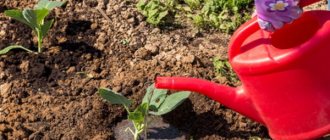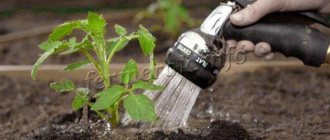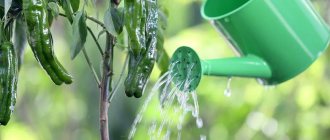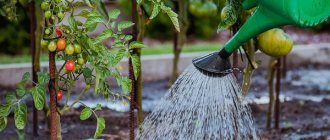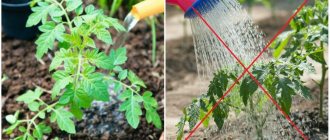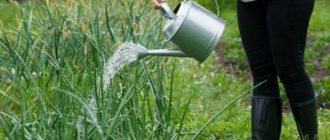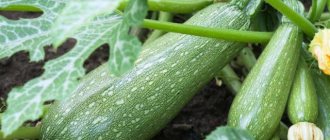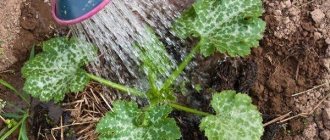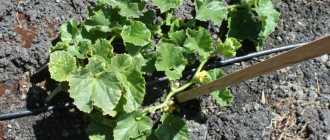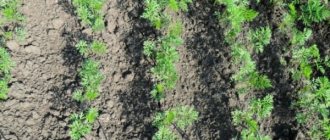Hello, dear friends! Today we will talk about how often to water garlic in the summer.
Many summer residents grow garlic in their gardens - a favorite seasoning for food and a valuable source of healthy phytonutrients. Regardless of whether you prefer to cultivate winter varieties planted in late autumn, or spring varieties sown in April-May, by the beginning of summer your seedlings have already formed a sufficient number of leaves and have begun to grow underground bulbs.
In June, as a rule, the weather is already quite hot, so the future harvest of juicy, aromatic bulbs will directly depend on the organization of watering the garlic plantation. Garlic is a drought-resistant crop, but regular, albeit rare, supply of sufficient water significantly improves the seedlings' absorption of nutritional compounds from the soil. These processes lead to an increase in the size of the heads and, accordingly, an increase in yield.
Frequency of watering garlic in summer
According to reviews from experienced vegetable growers, during dry periods, garlic beds should be watered once every 4-5 days. The amount of water should be such as to moisten the top soil layer to a depth of at least 20 cm (3-4 buckets for each linear
meter, water at the root).
Surface watering slows down the development of suction roots that absorb minerals and organic matter from deeper soil layers.
If there is precipitation, scheduled watering can be skipped, since excess moisture in the soil provokes root rotting. Moreover, during prolonged rains and cloudy weather on the plantation, it is worth digging drainage ditches through which excess water will drain, accumulating in puddles in different planting areas.
How do you fertilize garlic in the summer to increase the size of the bulbs?
After the next heavy watering or good rain, it is recommended to fertilize the plants with phosphorus and potassium using a solution of double superphosphate and potassium magnesia (20 and 10 g per 10 liters of water, respectively). The application rate is 1 bucket of solution per square meter.
Phosphorus helps strengthen the root system, and potassium is responsible for the formation of bulbs and their commercial quality. Winter garlic is fed in summer in June, after the procedure for removing flower stalks-arrows from bolting varieties. A
Spring garlic is fertilized with mineral compounds in early July, since it is during this period that the formation of bulbs is most productive.
Three weeks before the expected harvest date, stop watering the garlic. Excess water accumulated in the heads can cause deterioration in their keeping quality. This is especially important if you plan to store garlic for long-term storage for later culinary use in the fall, winter and spring. The last watering of winter garlic is carried out in late June-early July, and spring garlic - in mid-August.
Now you know how often you need to water garlic in the summer in any weather. We wish that the harvest of your favorite vegetable this season exceeds your wildest expectations!
See you later, dear friends!
- How to preserve garlic in winter Hello, dear friends! Today's story will be about how to preserve garlic in winter and the timing of harvesting garlic from the beds. Garlic that you planted in the fall (winter) is usually harvested at the end of July.
- How to properly plant garlic in the fall Hello, dear plant lovers! The topic of this article is “How to properly plant garlic in the fall.” Garlic for planting in the fall is called “winter”. Winter varieties of garlic mostly shoot, but there are also non-shooting varieties. TO.
- Preparing a bed for winter garlic Greetings, dear garden lovers! Many summer residents set aside a bed for winter garlic in their garden. Garlic seeds planted in the fall (cloves, single cloves, or aerial bulbs) overwinter in the soil so that they can grow early.
Processing onion beds in July
In mid-summer, vegetable crops need a lot of heat and light, nutrients and moisture. If there is a deficiency of such important factors, the onion will begin to develop much more slowly, causing the bulbs to begin to become smaller.
Onions in July. This month the plant has already developed well and has formed up to ten feathers. In the garden bed his greenery stands like a powerful wall! The onion turnip begins to grow. And it is during this period that the plant vitally needs both additional nutrition and good feeding.
In hot July weather, you need to actively water the onions and prevent the soil from drying out. Onion beds should be loose and moist throughout July. When watering, you should direct the stream of water to the row spacing, and not to the onion feather. Morning watering of the ridges is recommended. But getting moisture on the forming bulbs is undesirable, as the plants may begin to rot or become infected with downy mildew.
At the end of the month, you should feed the plants with potassium-phosphorus complexes. Such fertilizing will give the vegetable crop strength and the harvest will be large-fruited. Nitrogen cannot be applied in July, since such fertilizer will delay the ripening process of the crop and affect the quality of onions during storage.
The plant in the process of formation does not like temperature changes. Therefore, in cold weather it is better to cover the beds. Active watering should be completed in early August and the procedure of exposing the bulbs should be carried out for good ripening of the crop.
With this care, garlic and onions can produce a good and high-quality harvest. The garlic bulbs and heads will be large, juicy and of high quality. If everything is done correctly, the onion will be stored for a very long time.
Watering garlic plantings in open ground
Garlic is used in cooking to add rich taste and aroma to dishes. Due to its healing properties, the plant is used in folk medicine for the treatment and prevention of diseases. Gardeners use garlic tincture for fertilizing as a natural insecticide and fungicide. Growing this vegetable crop is not a hassle. But in the absence of abundant watering of garlic in open ground, its yield decreases. This is due to the underdeveloped root system of the vegetable. Knowing the features of care, you can grow a high-quality product.
Should I water the garlic?
This vegetable crop is moisture-loving, and if the soil is dry, the green feathers turn white. Lack of soil moisture negatively affects the taste of the heads. With insufficient irrigation and poor care of the beds, chemical reactions at the stage of vegetation and growth are inhibited.
The effect of irrigation on yield
Regardless of the growing region, the beds must be irrigated with sufficient water. Plant growth is also influenced by regional climate characteristics, in particular, the amount of natural precipitation. Regular watering of garlic is a kind of medical help for the bulbous crop. And it must be carried out in compliance with all the rules to obtain a bountiful harvest.
When to start watering
The peak need for water occurs after planting the plant in open ground. For the first shoots to appear, soil moisture must be at least 80%, so the first watering is given great importance.
Two weeks after the sprouts appear, irrigation should be done every 5-6 days, especially in hot weather. During the rainy season, no additional water is required. The intensity of watering increases when the garlic produces feathers and cloves begin to form. Subsequently, the soil is moistened as the top layer dries.
When to stop watering
After each moistening of the soil, you need to carefully inspect the beds: if the bulbs are exposed, they should be covered with earth. This recommendation must also be followed during the rainy season. As the cloves form and mature, watering is reduced.
Whether and when it is necessary to stop moistening the soil depends on the purpose of growing garlic:
- To extend shelf life in August, you should stop watering 20 days before harvest so that the garlic does not rot or deteriorate from excess water.
- For raw processing, irrigation is completed in 5-7 days.
Danger
If you violate the watering regime, certain consequences may occur.
Overflow
When irrigating onions, keep in mind that oversaturation with water is a rather dangerous factor for bulbous crops. If the amount of water exceeds the norm, then the risk of the development of pathogenic bacteria increases significantly, which affects the duration of storage after harvest.
In addition, onions that are oversaturated with moisture rot - because of this, turnips become inedible, which negates all your efforts.
No moisture
Lack of moisture has one significant drawback - the plant can significantly slow down its growth or even stop developing. Therefore, the issue of timely and standardized watering is very important.
Signs of lack or excess moisture
Water deficiency is manifested by bluish-white feathers and their further curling. Since this bulbous crop has an underdeveloped root system, it must be closely monitored during the growing season and in the first months of hot summer.
You can identify the abundance of moisture by characteristic signs: the tops lighten and gradually become faded green. Yellow garlic leaves can also indicate a lack or excess of water in the soil. Yellowed tops in the beds may indicate the presence of pests (onion fly, root nematode).
And most importantly, proper watering affects the size and quality of the bulbs. Depletion of the soil also negatively affects the yield.
How to deal with onion fly
With a little effort, onion fly infestation can be avoided. The first and most important method of prevention is early planting of seeds. The point of early planting is as follows: by the time the adults emerge from the ground and begin to reproduce, the plants will be strong enough to prevent the destructive process. Practice shows that strong onions and garlic, which have formed before the onion fly begins to reproduce, are affected much less.
- Carrot neighborhood. A great way to protect your crop from onion flies is to place your onion or garlic bed next to your carrot bed. Carrot roots secrete phytoncides - substances that repel parasitic adults.
- Tobacco dust. During the period when insects begin to reproduce, it is necessary to treat the beds with tobacco dust. To do this, both plant shoots and the soil between the rows are powdered with the substance. If there is not enough tobacco dust available, it can be mixed with lime in a 1:1 ratio.
How to water garlic
It is recommended to use salt water to moisten the soil. To do this, you need to dilute 200 g of sodium chloride in 10 liters of liquid. You need to water the garlic with the resulting salt solution when it has formed 3-5 leaves.
When garlic is watered with salt water, the soil is enriched with nutrients and parasites are destroyed. If arrows do not appear, it is recommended to spray and irrigate the beds with a weak solution of potassium permanganate in early spring.
Watering winter and spring garlic should be carried out in combination with fertilizer. Organic (mullein) and mineral supplements are used as top dressing. When growing winter varieties of garlic with a liquid solution, it is necessary to enrich the soil.
To prepare it, dilute 20 g of urea in 10 liters of water.
Features of culture
Garlic loves watering, especially if planted in open ground. To keep it large, it is recommended to water it abundantly. Garlic planted for the winter, that is, winter garlic, is not so demanding on watering, since it is constantly under the film and in the ground, and therefore receives enough nutrients from it during the growing season.
Initially, before planting a crop for the winter, you should not water it abundantly. You need to do this in a small amount, adding water and covering it securely with film. In spring, garlic will be nourished by melted snow and rain. When it gets warmer outside, you can open the garlic for a day so that it is not affected by frost. And also at this time, gradual sprinkling is carried out.
This culture loves moisture, and if the soil where it grows is dry, the feathers will become tasteless and white. Lack of moisture also negatively affects other qualities of garlic.
It is especially important to give the garlic good irrigation at the time of growth, when it forms a clove. At this point, you can also add additional fertilizing to improve conditions and enrich the soil with useful elements.
The main need for moisture occurs at the moment when it is planted in the soil so that the first healthy shoots appear. Humidity should be at least 80% at this moment, and therefore great importance is attached to watering during this period. When the first shoots appear, and this will happen one to two weeks after planting, it is necessary to water every 4-6 days. If the weather in the region is hot, then more often.
When there is constant precipitation outside, additional water for plants will not be required. It will be necessary to increase the intensity of watering at the moment when the plant produces feathers and its teeth form. In the future, moistening is carried out as the soil dries out. Experienced gardeners recommend watering at the rate of 10-11 liters of water per square meter. m of land.
After each watering event, you need to inspect the beds. If moisture has washed the bulbs out of the ground, they should be sprinkled. The same recommendations must be followed during rainy weather. As the plant forms and grows, the intensity of watering gradually stops.
To keep the product longer, watering should be completely stopped 20-25 days before harvesting. In this case, moisture will not accumulate in the teeth, and it will be able to lie and be preserved longer. If you need garlic for raw processing immediately after harvesting, then irrigation should be stopped 4-5 days before this point.
Since the crop does not have a very developed root system, watering must be carefully monitored, especially during the growing season and in the first days after that during dry summers. The moisture level is determined by several signs, the main one being the lightening of the tops. If the leaves turn yellow, this also indicates a deficiency or a large amount of moisture in the soil. In some cases, such a manifestation may indicate the presence of pests in the soil.
When growing this plant, it is worth remembering that moisture and its quantity affect the quality and size of the bulbs. In order for them to grow large, juicy and tasty, it is necessary to periodically fertilize the soil in the area where the crop is planted. This will have a positive effect not only on the appearance of the plant, but also on the yield.
To moisten the soil, use ordinary water to which a little salt is added. To do this, take a bucket of water and dilute 150-200 g of sodium chloride in it. This saline solution is poured onto the bed of garlic after it has sprouted, when 4-5 leaves have already formed on the stems.
If after the due date the arrows do not appear for a long time, you need to additionally irrigate the soil with a solution of potassium permanganate in a small concentration. This is done in early spring, 2-3 days after the expected emergence.
Spring and winter garlic is also watered in combination with the addition of fertilizers to the soil. For them, fertilizing is used as organic or mineral additives. These types of crops are usually irrigated with liquid solutions, which have a positive effect on both the condition of the plant and the soil.
How to water garlic
Manual irrigation
This type of soil moistening must be done in the morning and evening. In the daytime, watering garlic can cause burns on the plant. Before each irrigation, you need to focus on weather conditions.
Basic norms for watering garlic:
- once every 10 days, 10-12 liters per square meter at a temperature of 13-18°C;
- in dry weather - 10 liters, observing a break between moisturizing sessions of up to 4 days every two weeks;
- with sudden changes in temperature, during the rainy season, consumption is reduced.
Sprinkling
When using this irrigation method, water is sprayed from special installations in the form of microdrops. It is possible to evenly irrigate the garden plot and control moisture.
The advantages of this method of irrigation include the mobility of installations, ease of starting the system, and the possibility of simultaneous application of pesticides. Among the disadvantages are the high cost of equipment, high water consumption, dependence on liquid pressure and wind force.
Drip irrigation
When using this technique, the soil is moistened through a system of tubes with dispensers located throughout the entire area of the garden plot. The advantages include low water consumption, less evaporation compared to sprinkling, and a reduced risk of burns on garlic tops.
When choosing this method of irrigation, it is necessary to take into account that once every 3 years you will need to replace the ribbons of the irrigation device. Disadvantages are associated with clogging of droppers and the complexity of assembling and repairing the irrigation system.
Watering the garlic. How, when and how much
Watering garlic is of great importance for a good harvest, since the root system of garlic is relatively underdeveloped. Let's look at how to water garlic correctly.
Garlic plants are very demanding of moisture, which is due to the special development of the root system and the placement of a large number of roots close to the soil surface. However, thanks to the ribbon-shaped leaves, which in most varieties of garlic are covered with a waxy coating, garlic is also well adapted to atmospheric (not root) drought.
That is, garlic is one of those crops that poorly absorb moisture from the soil, but also use it sparingly.
Ukrainian garlic cooperative "UkrAP" offers:
Answers to frequently asked questions
When can you fertilize in the summer?
It is permissible to fertilize spring garlic throughout July, while for winter crops the last treatment is necessary. recommended in the first ten days of July.
Is it necessary to apply nutrient mixtures to fertile soil?
Excess chemical elements, including nitrogen, only harm the plant, so if the environment for the development of the vegetable is favorable, then additional fertilizing is not required.
Is it possible to eat garlic that has been treated with pest control drugs?
It all depends on the product itself that was used. Spraying is permissible no later than 2 weeks before harvest.
The effect of watering garlic on yield
Strict adherence to the water regime can significantly increase the yield of garlic.
To fully ripen, garlic requires a relatively equal amount of moisture, regardless of the growing region.
However, the characteristics of the regional climate (namely the amount of natural precipitation) directly affect the effectiveness of artificial irrigation of garlic.
Below are some data confirmed by official research:
- according to 1954 data (Kuznetsov A.V.), the difference in yield between irrigated and non-irrigated garlic plantings is about 35-42%
- in an arid region, the yield of garlic with drip irrigation was recorded to be 73% higher than without irrigation at all (2016 study)
If you have an artificial irrigation system for garlic, what is important is the possibility of controlled adherence to the irrigation regime (with the exception, of course, of particularly rainy periods, when, on the contrary, an excess of moisture occurs).
Also, with the help of an irrigation system, macro and micronutrients are delivered to the garlic.
Features of growing large garlic
To prevent garlic from getting sick and to grow large, it should be planted in the place where it was grown before:
- carrot;
- pepper;
- tomatoes;
- cauliflower.
Before planting winter garlic, the soil is dug up using a spade and potassium chloride, superphosphate, as well as compost or humus are added.
When planting a spring vegetable, the soil is dug up a month before planting, sawdust, ash, humus, bird droppings and lime are added. Then the soil is watered, covered with cardboard or film and left for a month.
To obtain large heads, garlic should be fed at least twice with mullein or chicken droppings. The first time is when it begins to germinate, and the second time is when the head forms. During this period, the soil is removed from the head of garlic (by a third or half), just like with an onion. This helps to obtain a larger, more beautiful and even head.
In order to get a high yield of this vegetable, you should remove all the arrows in time.
How to water garlic
When to start watering garlic
When to water garlic is determined depending on soil moisture measurements. For this purpose, a device for measuring soil moisture (moisture meter) is used.
In general terms, we can say that garlic should be watered when the humidity level on the device shows less than 70%
Soil moisture meter "Hydroscan"
Soil moisture meter MG-44
How to determine soil moisture without a moisture meter
In closed ground or with a high organic content
Take a handful of earth from a depth of 10 - 20 cm and squeeze it in your hand and open your palm:
- if the outline of fingers remains on the coma, the humidity is about 70%
- when the earthen clod crumbles, the humidity is less than 60%,
- protruding moisture on the coma - soil moisture above 80%.
In the open ground
- if the humidity is less than 60%, the soil will not form in a lump (except for heavy loams)
- if the ball is formed, but falls apart when lightly pressed, the humidity is in the range of 70 - 75%
- a denser ball, which feels wet when pressed, indicates the presence of moisture at the level of 80 - 85%
- on loamy soil, the ability to form a dense viscous lump indicates a humidity above 90%
Please note that garlic is not moisture resistant. Therefore, you should not over-moisten it. This may lead to damping off.
Watering garlic by sprinkling
Watering norms for garlic
Watering winter garlic in the fall
When planting winter garlic in the fall, in the first two weeks after planting it needs high soil moisture. At this time, teeth are sprouting and roots are growing intensively.
After planting garlic in dry soil, it should be watered.
Watering garlic in spring and summer
During different growth periods, garlic needs different humidity levels. You can use this table as a guide to determine the rate of watering of garlic.
It contains an approximate irrigation regime for Drip irrigation of winter garlic on medium loamy soil (lowest moisture capacity (MC) = 18.7%) and a planting pattern of 60+20 x 6 cm (1.60 m)
The optimal soil moisture during the period from germination to the formation of bulbs should be 80-85% of the total moisture capacity .
Without this, the yield and marketability of garlic are significantly reduced due to the formation of small bulbs.
However, about three weeks before harvesting, the humidity should gradually decrease to 60-70%, which promotes normal ripening of the bulbs.
It should also be noted that, according to literature data, the first spring watering can be omitted if the total precipitation during the autumn-winter period is 200 mm or more.
Total water requirement of garlic
USDA studies show that the optimal water requirement for winter garlic is 425 mm of moisture (including natural precipitation) from the beginning of the growing season in the spring until harvest (in California, loamy soil).
Watering garlic in furrows
How often to water garlic
Of course, the region where garlic is grown and the level of natural rainfall should be taken into account.
Taking into account maintaining the required humidity standards, garlic should be watered at an approximate interval - 1 watering every 7 days.
When to water garlic
It is best to water garlic in the morning so that the plants dry quickly - this reduces the incidence of disease .
Watering is not carried out if the average daily air temperature is below 15ºC. The water temperature should be no lower than 15 – 18ºС
When to stop watering garlic
As a rule, they stop watering garlic at different times depending on the purpose of cultivation:
- for storage - stop watering garlic 20 days before harvesting
- for processing in raw form (not for drying) - 5-7 days
Drip irrigation on a garlic field
Recommendations
In order to prevent diseases and all kinds of deviations in the development of garlic, experienced gardeners have developed a number of recommendations:
- I water the bed abundantly so that the soil is moist at a depth of 20-30 cm. Surface irrigation only promotes the growth of greenery.
- To reduce the number of waterings to a minimum, you need to mulch the bed with mown grass, sawdust or straw. In humid, cool summers, it is better to avoid mulching.
- Use warm water for irrigation (recommended temperature +18 degrees). It is not advisable to irrigate the garlic bed with ice water.
- Watering is canceled if there is heavy rain. After drizzling and light rain, the bed should be well moistened, since natural moisture is not enough for garlic to grow.
- During the daytime, moisture quickly evaporates from the ground - the bed is watered late in the evening or early in the morning.
- Throughout the growth of garlic, watering should be alternated with superficial loosening of the soil. This event helps reduce the number of weeds and prevents the formation of a soil crust.
Watering winter garlic after planting is very important if you want to get a good harvest in the future. Next year you need to follow the basic rules of watering so as not to harm the crop.
Garlic watering systems
Currently, in the industrial cultivation of garlic, the following methods of watering garlic are most widespread:
- sprinkling
- surface (ground) drip irrigation
- subsoil (underground) drip irrigation
Sprinkling. When watering garlic in this way, water is sprayed from sprinklers in the form of rain over the surface of the plants.
- mobility of irrigation systems
- relatively low labor costs to start an irrigation system
- does not interfere with soil cultivation
- possibility of applying pesticides
- high initial cost
- high water use
- the need for a large amount of energy to create the necessary water pressure
- dependence of watering quality on wind strength
- low efficiency on heavy soils in dry climates
- possible negative impact on leaf cover (mineralization, diseases)
Surface drip irrigation. With this system of watering garlic, water is supplied directly to the plant through a system of tubes with dropper dispensers laid out on the field.
Benefits of above-ground drip irrigation
- significantly less water consumption than with sprinkling
- less evaporation than with sprinkling
- Possibility of watering at low rates with short inter-irrigation periods
- does not cause burns on leaves
Disadvantages of above-ground drip irrigation
- the need to replace drip irrigation tapes every 1-3 years
- high labor intensity when laying out, assembling and repairing drip irrigation tapes
- clogging of droppers
Subsoil (underground) drip irrigation. This is a stationary irrigation system designed for many years of use. The system itself is practically no different from ground drip irrigation. Only drip irrigation pipes are laid in the ground and have increased wall thickness (from 16 mils). Special emitters are also used that prevent plant roots from penetrating through them.
Advantages of subsoil drip irrigation
- does not interfere with soil cultivation
- no need for annual laying/collection
- delivery of water and nutrients directly to the root system
Disadvantages of subsoil drip irrigation
- difficulty in diagnosing a non-working emitter
- difficulty in performing routine repairs
- maintaining the system to prevent the development of roots in the irrigation pipes
- higher initial cost than surface drip irrigation
It should be noted that existing studies do not reveal differences in crop yields when using above-ground or underground irrigation.
The video shows a selection of actions for organizing underground drip irrigation
To receive up-to-date information about growing garlic and the garlic business, follow us on Facebook, or enter your e-mail in the form on the right.
What fertilizing and fertilizer to apply in July for a large garlic bulb and so that it does not turn yellow
During the active formation of the bulb, garlic accumulates nutrients. During this period, products containing potassium and phosphorus are added. Such preparations have a positive effect on the growth process of the underground part of the vegetable and its ripening.
IMPORTANT! A common mistake in July care is adding nitrogen. Nitrogen-containing preparations cannot be applied in July, as they stimulate the growth of green mass, which prevents the development of a large bulb.
Mineral products
There are several types of phosphate and potash fertilizers on sale:
- monopotassium phosphate;
- superphosphate;
- potassium sulfate.
The manufacturer must indicate the method of use. Most often, the granules are diluted in a small amount of water, the resulting concentrate is left for 24 hours, and then dissolved in large volumes for root watering.
IMPORTANT! Chlorine-containing products destroy garlic, so they cannot be used to treat this crop.
Ready-made complex mixtures
In specialized stores you can find a lot of ready-made products intended for garlic in July. Among the most popular:
- Tsibulya.
- Biomaster.
- Agricola.
The preparations have a balanced complex composition, which will 100% affect the yield and size of the garlic bulb. Nutrient compositions are introduced in one of the following ways:
- root - when the solution is poured under the root of garlic or between the rows;
- foliar - the composition is sprayed over the ground part of the plant.
It is believed that foliar treatment allows you to quickly obtain the necessary microelements through the leaves. Nutrients are thus absorbed faster than with root watering.
Many fertilizers can be applied by foliar application, but to do this you need to reduce the recommended concentration by half.
Organic
Organic products work no worse than store-bought products. The most popular are:
- Ash,. The powder is scattered dry between the beds, then the fertilized soil is watered. Ash is also used in diluted form: 10 liters of water are poured into 0.2 kg, then infused for up to 3 days. The resulting solution is poured over the garlic - 5 liters per 1 square meter.
- Rotted humus. Use one 9 liter bucket per 1 square meter.
- Infusions of herbs and plant residues. Prepare at the rate of 1 part green mass to 3 parts water. The liquid is infused under the lid. Before use, the liquid is filtered and diluted 1 to 10 with water. 2 liters of fertilizer are consumed per 1 square meter.
Chicken manure and mullein are used to feed garlic, but they cannot be used in July, since fertilizers contain a large amount of nitrogen.
You can also find special humic fertilizers on sale to improve the growth of bulbs. Processing is carried out strictly according to the instructions.
Folk recipes
Along with organics, gardeners actively use inexpensive time-tested folk remedies. To feed garlic in July use:
- hydrogen peroxide 3% - 2 tablespoons per 1 liter of water. Only the leaves and stems will be treated with the resulting solution;
- iodine - diluted with water, 40 drops per 10 liters of liquid. Iodine is also sprayed over the ground part of the vegetable;
- yeast - for 100 grams of yeast, take 3 liters of water and 5 tablespoons of sugar, infuse the solution for 3 hours, then dilute it with water again, 1 to 10. Watering is carried out at the root.
REFERENCE . Any type of feeding must be carried out during a calm period, preferably in the evening or on a cloudy day.
Watering garlic in summer - what does garlic prefer?
Let's start with the fact that garlic loves light and grows well where there are open and dry beds. Loamy soil is suitable for this plant with a specific taste; if the soil type is acidic, it is advisable to lime such soil. If we talk about watering, then if there is a lack of water, you will notice everything from the feathers of garlic - they acquire a bluish-white hue, and its tips are bent. If the garlic has excess water, the feather will turn pale green.
How to water garlic? The answer to this question is the following - after planting, it needs to be watered once a week. We are talking about the season from May to June. Water calculation based on 5–10 liters per 1 m². In July, watering should be reduced somewhat - at this time the bulbs are fully ripened. The only exception is dry weather - then additional moisture is allowed, and this will prevent the plants from withering. Garlic itself does not like excess moisture in the soil. Based on this feature, you need to build a watering schedule. Your harvest will largely depend on it.
According to experienced gardeners, by choosing the right schedule and watering technique, the garlic harvest can be increased by up to 50%! But initially it seems that there is nothing complicated in such a process as watering garlic. When should you stop watering garlic? The correct answer is a month before digging it up. Vigilant gardeners have even created their own calendar - according to it, it is recommended to harvest garlic from July 12 to 17. It is during this period that the leaves turn yellow, which means the harvest is ripe.
The main difficulties encountered when watering with a hose are unwinding a long coil between the beds, trying not to damage the plants, and then, at the end of watering, winding up the heavy “sleeve” filled with water. But there is a way out if you purchase this unusual hose.
Unique garden hose for watering
We recommend that you read
It is short enough to be quickly deployed, but then, when water runs inside, it extends 3 times due to the different properties of the inner (hard) and outer (soft corrugated) shells. When you turn off the water, the hose will begin to shrink, returning to its previous size and, accordingly, will pull itself out of the rows. There are no alternative solutions, just, as before, unfolding and rolling up the heavy, difficult-to-give coil.
You can purchase a unique garden hose for watering here.
Soil moisture measurement
Garlic needs moisture when the soil saturation drops below 70%.
The optimal moisture content figure should be remembered and not allowed to fall during the season before the ripening period begins. To measure soil moisture, it is advisable to use a device - a moisture meter. The accuracy of the measurements will allow you to properly care for the plant.
But not all gardeners have it. In addition, some people feel sorry for the money to buy the device. Is there another way to measure soil moisture? Yes, for this they use the old-fashioned, manual method of measuring soil moisture. You just need to take a handful of soil from a depth of about 10 centimeters. You need to squeeze a handful and then open it. The results will be based on the following characteristics:
- 80% or more - liquid appears from the computer.
- 75–70% - the lump is a formed ball that crumbles when pressed.
- 70% - there are outlines of fingers on the lump.
- 60% - the lump crumbles.
Proper selection of humidity is important at the ripening stage. This will allow you to understand when to stop watering.
By taking note of the information on how to water garlic, you can grow a high-quality garlic crop.
It is required to strictly adhere to the watering regime, while paying attention to natural precipitation
It is extremely important to monitor them during the ripening period. To prevent the soil from becoming oversaturated with moisture from rain, create a drainage system on the ridge
To prevent the soil from becoming oversaturated with moisture from rain, create a drainage system on the ridge.
It is optimal to use a drip irrigation system as an irrigation system. Watering garlic in open ground with this system is simple and effective. It’s easy to make it yourself from available materials, even for small plantings. The manual method does not provide high accuracy, and because of this, the soil may be oversaturated with moisture. The drip system will bring water directly to the roots.
When to stop watering garlic? Before ripening, reduce the amount of moisture; towards the end, do not water at all.
https://dachamechty.ru/chesnok/poliv-v-otkrytom-grunte.html
Garlic - special signs and tips
It is believed that in order to correctly determine the maturity of a plant, we need to leave one or two flower shoots, and as soon as the peduncle bursts, we can eat the plant. Those who are planning to get planting material “for later” can leave the flower stalks to ripen. Gardeners advise to be sure to monitor garlic after heavy rainfall - if the bed dries out suddenly, it is advisable to immediately loosen the soil around the plant. This way, air can flow to the bulb through the topmost layer of soil.
Watering should be adjusted depending on the air temperature. In not very dry weather, with precipitation, about 10 liters of water will be needed per 1 square meter. Just take a mandatory break between waterings, about 9 days. When watering garlic, it is important to use water that has settled and warmed up in the sun for some time.
Preparing for landing
If you purchased onion sets in a store, you must immediately dry them in a warm place, spreading them out in a thin layer. It is not recommended to use a battery for this, since the temperature around it is usually higher than optimal. If the seeds have already been prepared and stored at a temperature not exceeding 18 ºС, then it also needs to be warmed up in order to activate the growth processes.
Warming up of the sowing is carried out in several stages, first it is stored at a temperature of 20 ºС for 15-20 days, after which for 9-10 hours the temperature should be raised to 30-40 ºС, but no more. This procedure is very important for activating growth, as well as for preventing the formation of arrows
When warming up, it is important not to allow the temperature to rise, as this can negatively affect its condition. If you missed the moment of gradual warming up of the set, then before planting it should be filled with hot water at about 50 ºС, kept for 10-12 minutes and cooled in cold water
Sevok responds very well to treatment with a stimulating drug, such as Zircon or Humisol, which accelerates its growth. Onions can also be placed for 6 hours in a solution with general mineral fertilizers.
And finally, the very last stage is the disinfection of onions in a solution of copper sulfate. This solution is prepared in the proportion of 10 liters of water to 1 teaspoon of the substance.
How to water onions - advice from professionals
Salad onions need regular watering. So don’t forget about water, from the moment of planting until the beginning of July. But when do they stop watering the onions? The answer is - in the middle of summer. During this period, it is necessary to frequently loosen the soil between the rows themselves. Onion feathers can remain green for a long time. If we are talking about growing onions, then cutting such a feather is not recommended, since you will not get a good onion.
If the onion turns yellow, experienced gardeners will tell you what to water it with. Most likely, the cause is a disease called bottom rot. In diseased plants, the leaves quickly die, while most of the roots rot, and the bulb itself becomes yellowish. To get out of this situation, it is better to buy certain varieties of onions that are not afraid of this disease. And one more piece of advice - planting onions in the old bed in the spring no earlier than after 3 years.
The basic rule is to use a fungicide solution before planting plants in the soil, and also pull out diseased seedlings in a timely manner.
Well, and the main thing is that the onion does not turn yellow, it must be watered correctly. However, the reason may also be insect pests, soil conditions, improper care of onions, or unfavorable weather conditions. If these are pests (maybe an onion fly or an onion fly), then we advise you to resort to this folk method - treat with a saline solution (take 200 grams of salt per 10 liters of water). You can increase efficiency by adding a small amount of ammonia.
Watering onions is an ongoing process. So, in the first two and a half months the plant is very demanding in terms of moisture. It is better to water both before and after weeding. It is better to pour water into the furrows that can be made between the rows. This way the onions will ripen quickly and can be stored later. For those who are interested in how to water onions on turnips - regularly in the first half of summer! When do you stop watering onions? – Already in the second half of summer, from the beginning of July. If it rains at this time, it is better to cover the crop with film - this way you will avoid excess moisture in the soil.
Soil moisture measurement
Garlic needs moisture when the soil saturation drops below 70%.
The optimal moisture content figure should be remembered and not allowed to fall during the season before the ripening period begins. To measure soil moisture, it is advisable to use a device - a moisture meter. The accuracy of the measurements will allow you to properly care for the plant.
But not all gardeners have it. In addition, some people feel sorry for the money to buy the device. Is there another way to measure soil moisture? Yes, for this they use the old-fashioned, manual method of measuring soil moisture. You just need to take a handful of soil from a depth of about 10 centimeters. You need to squeeze a handful and then open it. The results will be based on the following characteristics:
- 80% or more - liquid appears from the computer.
- 75–70% - the lump is a formed ball that crumbles when pressed.
- 70% - there are outlines of fingers on the lump.
- 60% - the lump crumbles.
Proper selection of humidity is important at the ripening stage. This will allow you to understand when to stop watering.
Onions - subtleties of care
If you decide to constantly water the onion from above, then this should be done through the mesh of the watering can - this way the very young onion will not be “bare” with a strong stream of water. You can determine when it is best to water the onions using your hand - if the soil is dry, then you need to water it, and if not, you need to postpone watering.
Watering should be done so that the water penetrates to the depth of the roots. When to stop watering onions? The correct answer is several weeks before harvesting. You cannot fill onions with water, otherwise excessive soil moisture can lead to the appearance of fungi and various diseases.
Little tricks to grow big onions
Using salt to protect plants from onion flies, gardeners noticed that its use significantly affects the increase in the size of the head. To make the onion much larger and juicier, it is watered with saline solution. Generously sprinkle the soil around the bulb with salt and water the soil. It is recommended to use salt no more than twice per season.
Another method will allow you to grow large heads of both onions and garlic. This method consists of loosening and removing the soil around the heads. Each head should be freed from the ground so that sun, water and air can freely flow to them. During this procedure, the soil should be dry, and the heads of garlic and onions should be almost formed.
The heads are freed from the soil by half or a third of the size of the head.
How often do you water onions and garlic?
Our vegetable garden consumes a huge amount of moisture during the season, evaporating some through the leaves, and using some to form greens and fruits. By organizing proper watering, the yield of the beds can increase significantly. And in this article we will look at a specific example of how often to water onions and garlic to get maximum results.
How often to water onions after planting?
Onions belong to the category of the most moisture-loving vegetables; with a lack of watering, their arrows change color to bluish-white, the quality of the bulbs decreases due to inadequate chemical reactions during the process of growth and development.
The highest need for water in onions is observed precisely after planting. From the emergence of seedlings to the beginning of the formation of bulbs, soil moisture should be at least 75-80%. In the first two weeks after sowing and another two weeks after germination, it is extremely important to provide the onions with abundant watering approximately every 4-6 days, provided that the weather is dry and hot. If it’s rainy outside, additional watering is not needed.
Also, high-quality watering is required when the onions put out leaves and the formation of bulbs begins. Next, the amount of water needs to be reduced.
How often should you water onions on turnips?
If you grow onions for turnips, you need to remember that the yield is ensured by the moisture of the top layer of soil to a depth of 30 cm. This can be easily checked by digging the soil in the garden bed with a shovel. Excessive overwatering of the plant during the period of bulb growth, when you pull out a shovel with a solid sticky lump of earth, leads to the fact that excess moisture delays the ripening process of the bulbs and reduces their keeping quality.
How often to water garlic in open ground?
Garlic is more of a water-saving plant. It loves watering, but is able to withstand a week between waterings. So to the question of how often you need to water garlic, the answer is more likely no than yes.
In the period after planting, that is, in May and June, it is enough to irrigate it once a week. In July, watering is stopped altogether, as the ripening period begins. But if the weather is dry outside, then you can water it to prevent the plant from wilting, which manifests itself as bending the tips of the feathers and changing their color.
Two ways to plant onion seeds for seedlings
Method No. 1. The so-called “boiling water” method.
To do this, fill a deep (about 15 cm, no less) container with earth. Soil for sowing: soil for seedlings, neutral peat 1/6 part, perlite or vermiculite 1.8 part, vermicompost 1.8 part.
We take a spoon - a slotted spoon and water the ground with hot water of about 75 degrees, no less. Spread the seeds over the surface. The seeds are small, but try to space them about 1cm apart. We fill in 0.5 cm of soil and pour hot water on top again. But this time the water should be a little colder. Approximately 60-65 degrees. We close the box with a bag and put it in a warm place until the loops appear. Then, when the shoots have appeared, we put the box in a cool, bright place. The ideal temperature for germination of onion seeds is 18-20 degrees. Onions absolutely cannot stand heat and dry air, and they should not be over-watered. It must be watered carefully, preferably from a pear or a syringe.
Method number 2. In the “snail”.
I take a backing for the laminate, but not very thick. I cut it 15-18 cm wide, and the length will be the same as how many seeds you spread. When you spread the backing, place paper napkins on it, moisten it with water and Epin, or better yet, Chlorella Suspension.
Place the seeds approximately 1 cm from the top edge. Then carefully roll it into a tube and secure with rubber bands or tape. Place this snail in a jar or glass with a solution of Chlorella or Epin suspension, cover with a bag and place in a warm place until the seeds germinate. After the onion sprouts, soil will need to be poured into the snails.
When adding to the snail, I water the soil well with phytosparin or silver medite. Onions love to eat and need nutritious and loose soil. I don’t just plant in the ground, but I make up the soil. It includes soil for seedlings, perlite or vermiculite, lowland peat and vermicompost. The soil should be moist and sticky so as not to spill out of the snail.
We unwind the snail and carefully lay out the earth along its entire length and width, about 2 cm. Then we carefully wrap the snail and put it in a cool place. This way the onion will live until planted in the ground.
You can learn how to grow onion sets from this material >>>>>.
Onion seeds must be fresh
